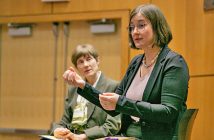Mary, Queen of Scots, the 16th century monarch who has been considered both a woman of “uncertain reputation” and a Catholic martyr, played a crucial role in Catholicism’s history, a British scholar told an audience at Fordham University as part of the inaugural St. Robert Southwell, S.J., Lecture on Monday, Oct. 22.
Mary, who lived from 1542 to 1587, is most famous for her conflict with her Protestant cousin, Elizabeth I, for control of England, which would ultimately lead to Mary’s execution and her veneration as a Catholic martyr.

Patrick Collinson, Ph.D. Photo by Bruce Gilbert
“Mary knew that her future, beyond the grave, depended upon her personal identification with an uncompromising Catholicism,” said Patrick Collinson, Ph.D., Regius Emeritus Professor of Modern History at the University of Cambridge. “She prepared for her own posterity as a martyr in the famous portrait which became an icon of the developing Counter-Reformation: Mary’s unusual height accentuated, wearing a black velvet dress, a great gold rosary hanging from her belt – an object of devotion across Catholic Europe.”
Collinson discussed the monarch’s life with a standing-room-only crowd at Flom Auditorium in the William D. Walsh Family Library on the Rose Hill campus. A devout Catholic, Mary Stuart acceded to the Scottish throne when she was less than a year old and spent the last 19 years of her life in prison before being beheaded in 1587 at the age of 44 in the Great Hall of Fotheringhay Castle.
“Making a good death was an art form in the 16th century,” Collinson said, “and there was something about the way she presented herself, even the way she dressed, when she got up to the scaffold that made her a self-fascinating figure to others.”
The St. Robert Southwell, S.J. Lecture Series at Fordham University is devoted to the history and theology of the Christian church in the early modern period. It focuses on the scholarship of the Reformation and the Counter-Reformation, in Europe and the Americas, from 1500 to 1750. One lecture is delivered in the series each semester during the academic year.


